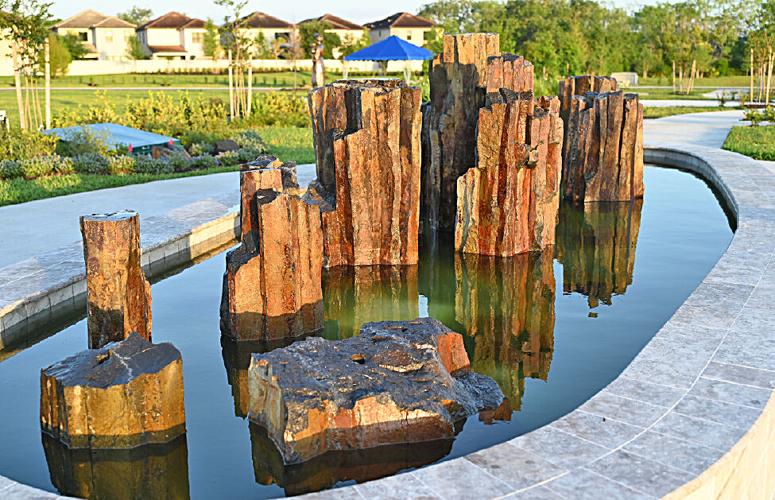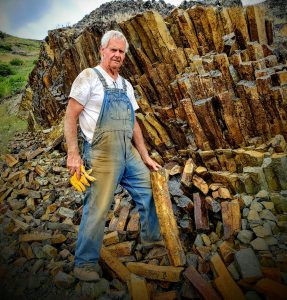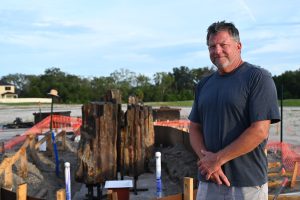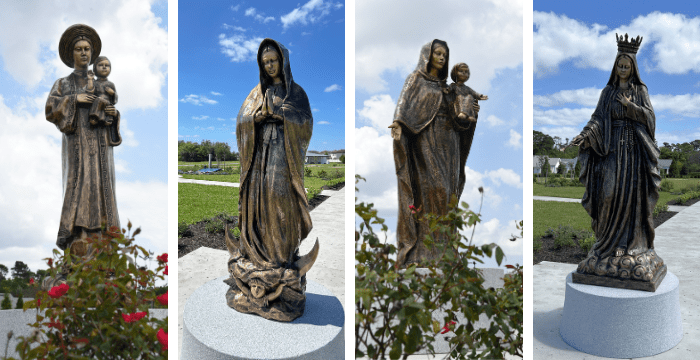
WINTER PARK | Forty-five-million-year-old igneous rocks now stand surrounded by four Marian statues and hundreds of gravesites at Queen of Angels Cemetery, Phase Two, in Winter Park. The Rock of Our Salvation fountain is a symbol of God’s omnipresence, from creation through eternity.
Installation began Sept. 9, 2024, and took several days of meticulous positioning by artist Robert Wertz and geologist Greg Prescott despite being saturated by frequent rainfall. But Wertz and Prescott began selecting the rocks well before that. Over several weeks, the two visited the Beaver Canyon quarry in the Okanagan Highlands of Washington state numerous times, selecting ideal pieces.

Prescott, a veteran geologist of more than 40 years, was first captivated by the aesthetic of the rocks when he discovered them through his late business partner, Bob Jewett. Both seasoned geologists had seen thousands of columns of basalt across the Pacific Northwest and beyond, but none so distinct in shape and coloration. Prescott explained the columns are usually dark and symmetrical, but these tell the story of their formation.
“I’ve never seen anything like it,” Prescott said. “And I know of no other occurrence in the world.”
In a simplified summary, the rock was formed from the lava flow of the Klondike Mountain Formation which poured into a caved in, faulted block of earth near the end of the Tertiary Period, the first age of the Cenozoic Era. “As is typical at the changing of the great geologic eras there was widespread crustal violence,” he explained. “The Mesozoic Era, the age of the reptiles, had just ended, and the Earth was rocked by great upheavals.”
Multiple volcanic eruptions took place, filling the valley. Over thousands of years, the pile of lava flows cooled and in Beaver Canyon, began crystallizing, creating the vibrant colors for which these columns are noted.
The crystalized minerals contain magnesium oxides that create dark swathes, along with iron oxides that create orange and red earth tones that become encapsulated in silica. It is this detail that prevents the rocks from discoloration. Otherwise, you could simply rub the color off. Like human beings, each rock is unique.
“There is a story written there,” Prescott said. Observing how people are drawn to the rock structures, he believes they are “searching for something lasting, permanent, and beautiful” and find elements of that in the rocks.
Each rock has water springing from its center, spilling into a pool beneath it. In Christianity, water represents life and purification. Although many metaphors can be drawn from the fountain beginning with the waters of Baptism bringing new and eternal life, cemetery director for the diocese David Branson had something specific in mind. The idea is that hope springs eternal, calling back to Moses and the Exodus. This stone too harkens back to the creation of the world.

The Rock of Our Salvation fountain recalls the moment God told Moses to strike the rock in the desert to quench the thirst of the Israelites during the Exodus — who thirsted physically and spiritually. Ex 17:6 reads, “I will be standing there in front of you on the rock in Horeb. Strike the rock, and the water will flow from it for the people to drink. Moses did this, in the sight of the elders of Israel.”
The visual effect of these ancient rocks pouring forth water also makes Christ present, immersing visitors into the New Testament recalling 1 Cor 10:4, “and they drank the same spiritual drink, for they drank from a spiritual rock that followed them, and the rock was the Christ.” Both verses will be inscribed on a plaque by the fountain.
The connection is not lost on Wertz. “I’m a believer and when I go out to the quarry, I feel closer to God there than 16 sermons. I look at it as something God created. He created the earth, the universe, beautiful things like this on the planet – most people don’t get to lay their eyes on,” he said.
As the florist at his church, he makes bouquets using the same design principles he uses in designing his structures, considering the elevations, variations, and continuity. “To me it’s a devotional thing in the morning, in the garden, saying, ‘This is for you, Lord. What do you see? Help me see what’s beautiful here. I carry the same thing into this,” he said.
He recalled a day during the installation. As he and Prescott were leaving, they saw a man standing, staring at a headstone in the cemetery. They both commented they hoped he hadn’t lost a child. Forty-five minutes later, after they returned, he was still standing there. “People are processing some pretty heavy stuff when they’re here,” Wertz said. “For someone like that man, a place like this is important. If people can come here and have something beautiful touch them in that moment, that’s a worthwhile contribution.
“I look at God as being the ultimate designer and creator. So, what I’m doing is just taking something He made and presenting it so people can see it. That’s important to me,” he continued. “Life is chaotic, hectic, stressful. There are losses, there’s grief, and there’s all kinds of negativity. When we can stop and see beauty, and truly relax, I think we ought to have a beautiful setting and focal point to do that.”
Queen of Angels Cemetery Phase 2 is open. For information, visit here. To watch footage of the igneous rocks, click here.
By Glenda Meekins of the Florida Catholic staff, June 13, 2025



